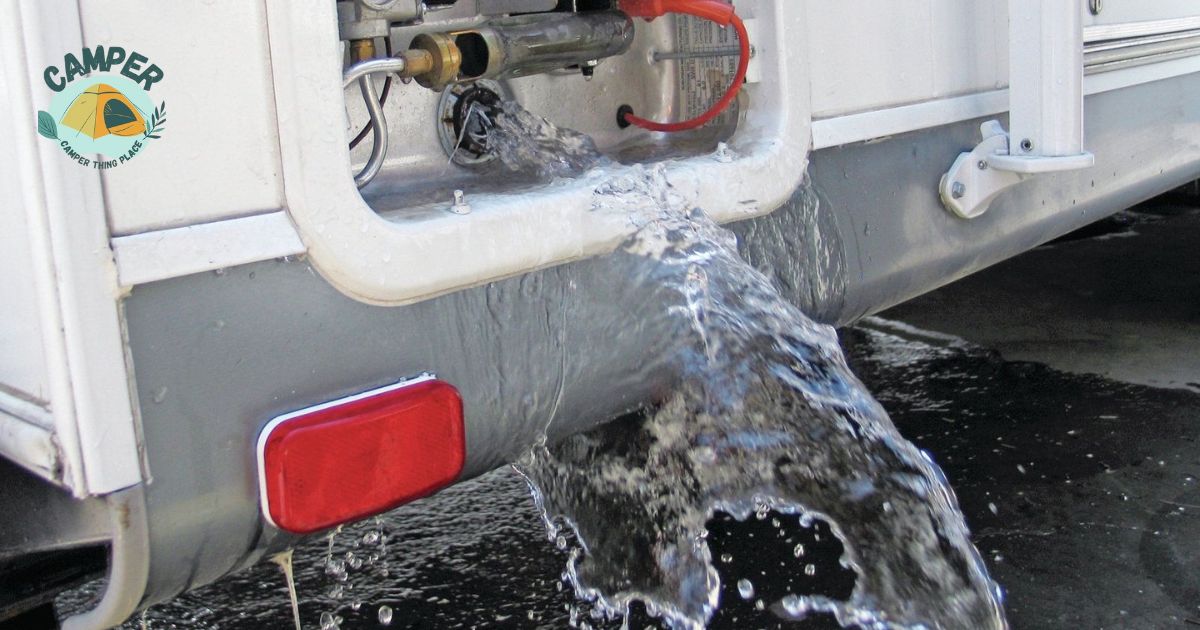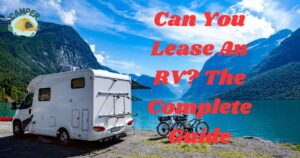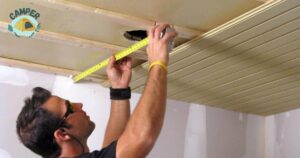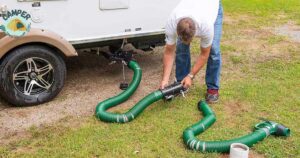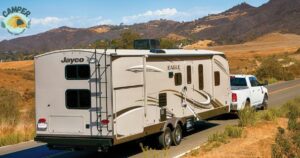Water damage can ruin an RV when excessive water infiltrates its structure, affecting vital components. Severe water damage in an RV refers to a condition where the overall harm is extensive, compromising the vehicle’s safety, structure and functionality.
Picture this a serene road trip in your beloved RV, but a hidden culprit lurks water damage. As innocent as it may seem, water damage can be the silent wrecking force that transforms your dream ride into a costly nightmare. Here some people ask How much water damage is needed to total an RV? Let’s delve into the world where water damage turns a leisure vehicle into a total loss, unraveling the tale of unsuspecting journeys gone awry
Totaling an RV due to water damage requires a significant level of harm to critical components. If water infiltration compromises the vehicle’s safety, structure, and functionality extensively, it may be deemed a total loss. Assessing the extent of water damage is crucial in determining whether the RV is salvageable or if the damage surpasses the point of cost-effective repair
How Do RVs Get Water Damage?
RVs may face water damage for various reasons. One common culprit is leaks, such as those caused by a damaged RV awning. When rainwater sneaks through damaged seals, cracks, or seams in the RV’s roof, it can find its way inside, causing damage over time.
Another issue arises from plumbing problems. If there’s a leak in the pipes or a faulty connection, water can seep into the RV’s structure, leading to potential damage and mold growth.
If you want to ensure the longevity of your RV and prevent water-related issues, it’s crucial to address and regularly clean RV awnings, as they play a key role in maintaining the vehicle’s integrity.
Additionally, condensation poses a risk. When warm air inside the RV meets cooler surfaces, like windows or walls, it can create moisture. If not properly ventilated, this moisture may contribute to water damage.
To prevent these issues, regular inspections, prompt repairs, and proper ventilation are crucial for maintaining an RV in top condition.
Movement & Vibrations
RVs are constantly on the move, and while this is part of the adventure, it can also be a source of water damage. The continuous vibrations and jostling during travel can compromise the integrity of seals and seams.
Over time, this wear and tear creates openings for water to seep in, especially during heavy rain or unexpected downpours.
Prevention Tip: Regularly inspect and reseal seams and seals, paying close attention to areas around windows, doors, and roof edges.
Water & Sun Damage
Exposure to the elements is inevitable for RVs, and prolonged exposure to water and sunlight can take a toll. Water damage often begins subtly, with small leaks that may go unnoticed.
Over time, these leaks can lead to structural damage and mold growth. Sunlight, on the other hand, can weaken materials, making them more susceptible to water infiltration.
Prevention Tip: Park in shaded areas when possible and invest in RV covers to shield your vehicle from prolonged sun exposure.
Punctures & Scrapes
The adventurous spirit that drives RV enthusiasts to explore off-the-beaten-path destinations can inadvertently lead to punctures and scrapes.
Sharp branches, rocks, or debris on the road can cause damage to the exterior, creating openings for water to find its way inside.
Prevention Tip: Be cautious while driving in unfamiliar terrain, and consider installing protective guards on vulnerable areas of your RV.
Plumbing Issues
Faulty plumbing is a common culprit of water damage in RVs. Leaky pipes or connections can lead to water accumulation in hidden spaces, causing damage over time.
Freezing temperatures can exacerbate the issue, leading to burst pipes and more severe water-related problems.
Prevention Tip: Regularly inspect your RV’s plumbing system, fix leaks promptly, and consider adding insulation in colder climates.
How to Prevent RV Water Damage?
RV water damage can be a real hassle. To keep your RV dry and cozy, follow these simple tips. First, regularly inspect the roof and seams. Fix any cracks or gaps you find to stop water from sneaking in.
Next, seal windows and doors tight. A snug seal keeps rain outside where it belongs. Don’t forget the vents cover them to prevent water from trickling in. Lastly, clean those gutters. Clear gutters help rainwater flow away from your RV, avoiding potential damage.
These quick steps will keep your RV dry and ready for your next adventure. Now, let’s talk about plumbing. Insulate pipes to prevent freezing, especially in colder climates. When winter hits, drain the water tanks and lines to avoid any unwanted surprises.
Check for leaks in the plumbing system regularly and fix them ASAP. Finally, invest in a good RV cover to shield your vehicle from the elements. By taking these precautions, you’ll ensure your RV stays water-damage-free and ready for your next road trip.
Routine Inspections
Establishing a routine inspection schedule is crucial for preventing water damage. Regularly check the roof, seals, and seams for any signs of wear or damage. Pay attention to the interior as well, ensuring there are no hidden leaks or water stains.
Fix Leaks Immediately

Rapid action is essential when dealing with leaks. As soon as you notice any water intrusion, address the issue immediately. Ignoring even minor leaks can lead to extensive and costly damage in the long run.
General Upkeep
Maintaining your RV in top condition is a proactive approach to preventing water damage. Keep the exterior clean, perform regular maintenance on seals and seams, and invest in quality materials for repairs.
How to Determine if Water Damage Has Totaled an RV?
Spotting water damage in an RV is crucial. Begin by inspecting the walls and ceiling for discoloration. If you notice any, it could be a sign of water infiltration. Look for soft spots on the floor, indicating potential damage.
Check for musty odors; a moldy smell may hint at hidden water issues. Be thorough in examining seams and seals, as these are common entry points for water. Additionally, inspect the RV’s exterior for cracks, especially around windows and doors.
These simple steps help you assess if water damage has taken a toll on your RV. Always stay vigilant to keep your RV in top shape.
RV Inspection Unveiling the Signs
Understanding the telltale signs of water damage is crucial for early intervention. Regular inspections should include:
Common Signs of Water Damage
- Musty Odors: A moldy or musty smell can indicate hidden water damage.
- Discoloration: Stains on walls, ceilings, or floors may hint at leaks.
- Soft Spots: Walk around and inside the RV, paying attention to any soft or sagging areas.
- Mold and Mildew: Visible growth suggests a moisture issue that needs attention.
- Warped Panels or Flooring: Changes in shape can signify water absorption.
- Repair Costs Assessment: Planning for Restoration
Assessing the extent of the damage is vital before delving into repairs. Consider.
Factors Influencing Repair Costs
- The extent of Damage: Minor leaks versus extensive water infiltration require different approaches.
- Materials Affected: Repairing damage to the RV structure versus interior furnishings has varying costs.
- Labor Costs: Professional repairs may be pricier but ensure quality and expertise.
- RV Valuation: Determining the Impact
Understanding how water damage affects your RV’s overall value is crucial for decision-making.
Factors Influencing RV Valuation
- Age and Condition: Newer RVs with minimal damage hold a higher value.
- Extent of Water Damage: The more significant the damage, the lower the valuation.
- Upgrades and Features: Well-maintained and upgraded RVs can mitigate the impact of water damage.
- DIY Repairs (Optional): Taking Matters Into Your Own Hands
For the hands-on enthusiasts, some minor water damage repairs can be done independently.
DIY Repair Tips
- Sealing Leaks: Identifying and sealing leaks promptly can prevent further damage.
- Replacing Damaged Panels: DIY replacement of small, affected panels can save costs.
- Mold Remediation: Safe and effective removal of mold is essential for a healthy living environment.
The Consequences of Ignoring Water Damage
Water damage, if left unattended, can wreak havoc on your RV. From compromising structural integrity to fostering mold growth, the consequences are vast and impactful.
Financial Implications
Ignoring water damage can translate into a substantial financial burden. The costs associated with repairing structural damage, replacing damaged components, and addressing mold infestations can quickly escalate.
The adage “a stitch in time saves nine” holds; that early intervention is not just a matter of convenience but a financial necessity.
Impact on RV Longevity
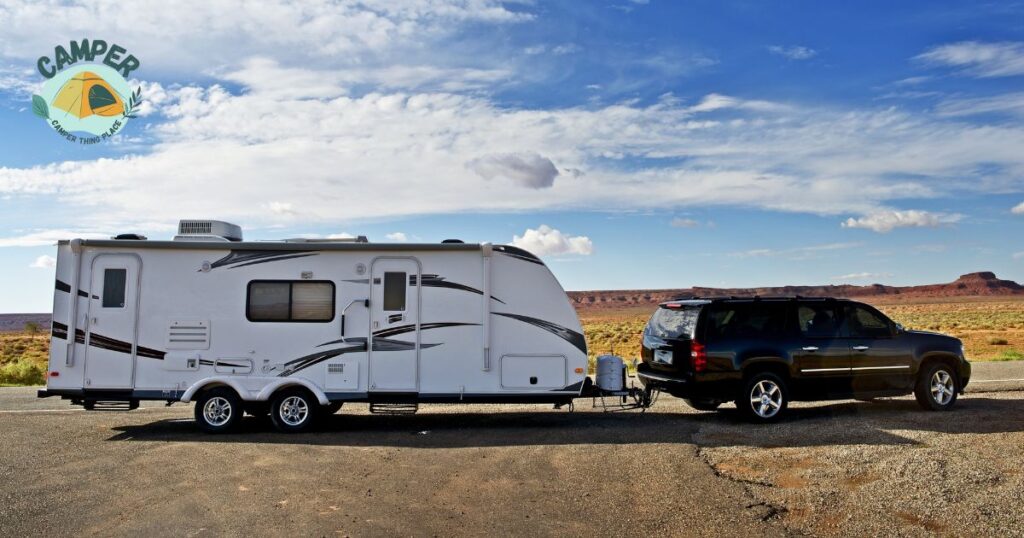
Water damage poses a direct threat to the lifespan of your RV. The structural components, the very framework that supports your mobile lifestyle, can deteriorate over time if exposed to water infiltration. Timely repairs and preventative measures are essential to ensure your RV stands the test of time.
The Importance of Regular Inspections
To mitigate the risks of water damage, regular inspections are paramount. An RV is a dynamic structure exposed to various elements during its journey.
Regular checks enable you to identify potential issues before they escalate, preserving both your investment and your peace of mind.
Visual Inspections: Take the time to visually inspect your RV, paying attention to seams, seals, and roof areas. Look for signs of discoloration, warping, or peeling that may indicate water infiltration.
Seal Checks: The integrity of seals around windows, doors, and vents is crucial. Damaged or worn-out seals are prime entry points for water, and replacing them is a small investment compared to potential repairs.
Professional Assessments: Consider periodic professional inspections. Experts can identify hidden issues, conduct thorough moisture tests, and provide recommendations tailored to your RV’s specific needs.
Assessing the Extent of Water Damage
Understanding the depth of water damage is pivotal for effective intervention. Differentiating between surface-level issues and those that have penetrated deeper is essential.
Visible Signs: Stains, discoloration, or soft spots on walls, ceilings, or floors are telltale signs. Addressing these early can prevent further deterioration.
Smell Test: Mold and mildew produce distinctive odors. If you detect musty smells, it’s crucial to investigate and remedy the source promptly.
Use of Technology: Moisture meters and infrared cameras can be invaluable tools for assessing the extent of water damage. They enable you to identify hidden issues not visible to the naked eye.
Delving into the Assessment Process
Expanding on our exploration, let’s delve deeper into the assessment process, providing you with a comprehensive guide to understanding and dealing with water damage in your RV.
Signs Indicating Water Damage
Recognizing the signs of water damage is the first step in effective intervention. Keep an eye out for:
Discoloration
- Stains
- Soft spots
- Warping
- Musty odors
- Visual Inspection Techniques for RV Owners
As an RV owner, conducting regular visual inspections is within your purview. Equip yourself with knowledge on:
- Seals and seams
- Roof conditions
- Interior surfaces
- Window and door frames
- Professional Assessment Methods
While DIY inspections are essential, professionals bring expertise and specialized tools to the table:
Threshold include:
- Severity of damage
- Cost of repairs
- Insurance company thresholds
- Breaking Down the Total Loss Equation
The term “total loss” can be daunting, but breaking down the equation clarifies the process:
Classifying Water Damage Severity
Classifying water damage severity is a critical aspect of effective remediation and restoration efforts. Water damage can result from various sources such as floods, leaks, or burst pipes, and its impact can range from minor inconveniences to significant structural damage.
Utilizing a systematic classification system allows professionals to assess the extent of the damage accurately and prioritize appropriate interventions.
One common classification system involves categorizing water damage into different classes and categories.
Classes refer to the extent of the damage, with Class 1 indicating minimal water absorption and minimal impact, while Class 4 represents severe damage with saturated materials requiring specialized drying techniques
Mild Water Damage
Mild water damage may start as inconspicuous leaks, often overlooked. These can lead to damp spots, discoloration, or a musty odor. Regular inspections are key to catching mild damage early.
Moderate Water Damage
Moderate damage involves more extensive infiltration, affecting larger areas. Signs include visible water stains, warped surfaces, and compromised structural integrity. Timely intervention is crucial to prevent further escalation.
Severe Water Damage
Severe water damage poses a serious threat to your RV’s integrity. This level involves extensive flooding, structural deterioration, and potential mold growth.
Flooring
Water can seep into the flooring, causing warping, soft spots, and mold growth. Regularly inspecting and promptly addressing leaks can prevent costly flooring repairs.
Walls and Ceilings
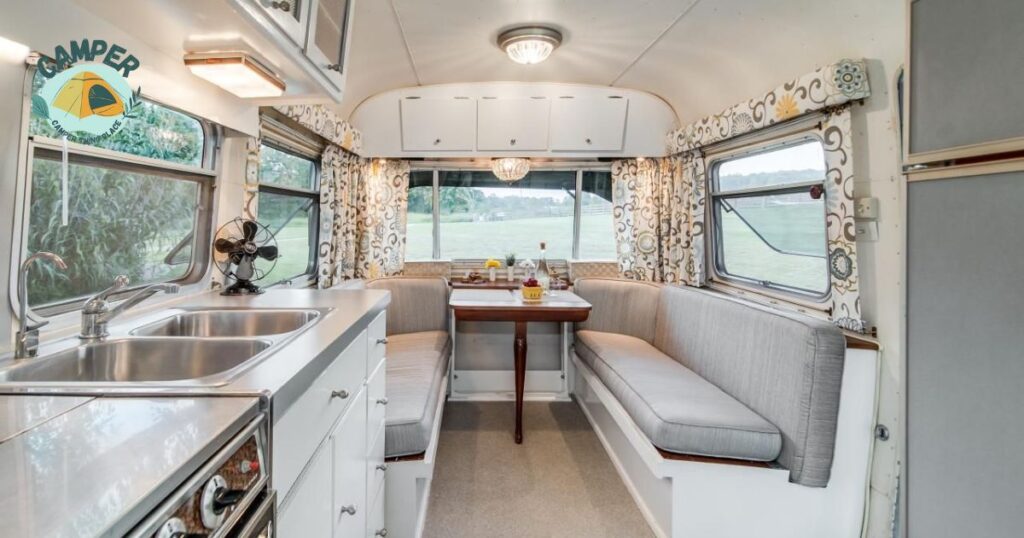
Unattended water damage can lead to compromised walls and ceilings, affecting both aesthetics and structural stability. Addressing leaks promptly is crucial to preventing extensive repairs.
Electrical Systems
Water and electricity don’t mix. Water damage can short-circuit your RV’s electrical systems, leading to malfunctions or, in extreme cases, fires. Inspect your wiring regularly and address any issues immediately.
Insulation
Once the insulation is soaked, it loses its effectiveness and can become a breeding ground for mold. Regular inspections and proactive measures are essential to preserving your RV’s insulation.
Insurance Considerations and Claims Process
When it comes to insurance, you need to think about a few important things. First, make sure you understand your insurance coverage. Different policies cover different things, like accidents, theft, or natural disasters. Check your policy to know what’s included.
If you ever need to make a claim, follow the claims process carefully. Contact your insurance company as soon as possible and provide all the necessary information. They will guide you through the steps, and it’s important to be honest and detailed. Keep records of any documents or conversations related to your claim. Being clear and prompt helps the claims process go smoothly.
RV Insurance Coverage for Water Damage
Most RV insurance policies cover water damage caused by accidents, storms, or leaks. However, coverage may vary. Check your policy for specific details on what is and isn’t covered.
Filing a Water Damage Claim
In the unfortunate event of water damage, filing a claim promptly is essential. Document the damage with photographs, gather receipts, and provide a detailed account of the incident. Be thorough to maximize your claim’s chances of approval.
Tips for Maximizing Insurance Benefits
To maximize insurance benefits, act swiftly, provide detailed documentation, and work closely with your insurance adjuster. Seek professional opinions and estimates to strengthen your claim.
DIY Repairs vs. Professional Restoration
When it comes to fixing things around the house, you’ve got options. DIY repairs are for the hands-on, adventurous types. You can try to patch up that leaky faucet or repaint the chipped walls yourself.
It’s a chance to learn and save some bucks, but it might not be perfect.On the flip side, there’s the professional touch. When you hire experts, you’re paying for experience. They know the ins and outs, ensuring a job well done.
It might cost a bit more, but you get quality without the stress. So, DIY or go pro? It depends on the task and your comfort level a bit of trial and error or a polished result with the help of a pro.
Pros and Cons of DIY Repairs
DIY repairs can save money, but they come with risks. Inadequate fixes may lead to recurring issues or exacerbate the damage. Only attempt DIY repairs if you have the necessary skills and knowledge.
Benefits of Hiring Professional Restoration Services
Professional restoration services offer expertise and comprehensive solutions. They can assess the full extent of the damage, address underlying issues, and provide long-term solutions. Professionals can also navigate insurance intricacies on your behalf.
Cost Considerations and Long-Term Outcomes
While DIY repairs may seem cost-effective initially, professional restoration can save you money in the long run by preventing further damage and ensuring thorough repairs. Consider the long-term outcomes when deciding where to invest your resources.
Preventive Measures to Safeguard Your RV
Taking preventive measures is essential to keep your RV safe and in good condition. Firstly, regularly inspect your RV’s tires for signs of wear and tear, and ensure they are properly inflated. This helps prevent blowouts and ensures a smoother, safer ride.
Additionally, check all the fluid levels, such as oil, coolant, and brake fluid, to keep your engine running smoothly. Secondly, safeguard your RV by securing all doors and windows when not in use. This helps prevent theft and unauthorized access.
Consider investing in a reliable alarm system for added security. Lastly, before hitting the road, double-check all electrical and plumbing systems to avoid any unexpected issues during your journey. These simple preventive measures can go a long way in ensuring a worry-free and enjoyable RV experience.
Maintenance Tips for Preventing Water Damage
Regularly inspect your RV for leaks, especially after storms. Check seals, seams, and caulking. Address any issues promptly to prevent water infiltration.
Seasonal Checks and Recommended Precautions
Perform seasonal checks before embarking on your adventures. Inspect your RV’s roof, windows, and plumbing. Take precautions during winterizing and DE winterizing to protect against freezing and thawing.
Importance of Proactive Measures
Proactivity is the key to safeguarding your RV from water damage. Regular inspections, timely repairs, and preventive measures can prolong the life of your vehicle and ensure worry-free travel.
Frequently Asked Questions
Is all water damage covered by RV insurance?
Coverage depends on the policy comprehensive insurance often covers water damage.
Can I repair the water damage in my RV myself?
Minor repairs may be possible, but extensive damage may require professional help.
How does water damage affect the RV’s resale value?
Significant water damage can substantially reduce the resale value of an RV.
Can water damage impact the RV’s structural integrity?
Yes, prolonged water damage can compromise the structural integrity of an RV.
Final Thoughts
Water damage can be a serious threat to the structural integrity and overall well-being of an RV. When water infiltrates the various components of the vehicle, such as the walls, floors, and ceilings, it can lead to extensive and often irreparable damage.
This damage not only compromises the safety of the RV but also diminishes its resale value and overall lifespan. To prevent the need to total an RV due to water damage, regular maintenance, and prompt repairs are crucial.
Inspecting the roof, windows, and seals for potential leaks, and addressing any issues immediately, can go a long way in preserving the integrity of the RV. Additionally, storing the RV properly during periods of non-use and investing in quality waterproofing measures can contribute to avoiding the devastating effects of water damage. A common question that arises in this context is, How much water damage is needed to total an RV?” The answer to this question varies depending on the extent of the damage and the cost of repairs compared to the RV’s value. Proactive steps to protect against water damage are essential not only for the safety and longevity of the RV but also to avoid reaching a point where the accumulated damage necessitates declaring the vehic

Jackson Ray, a seasoned blogger with a decade of experience, is the creative mind behind “camperthingsplace.com.” Explore his wealth of insights and passion for camping through engaging content on the website.
